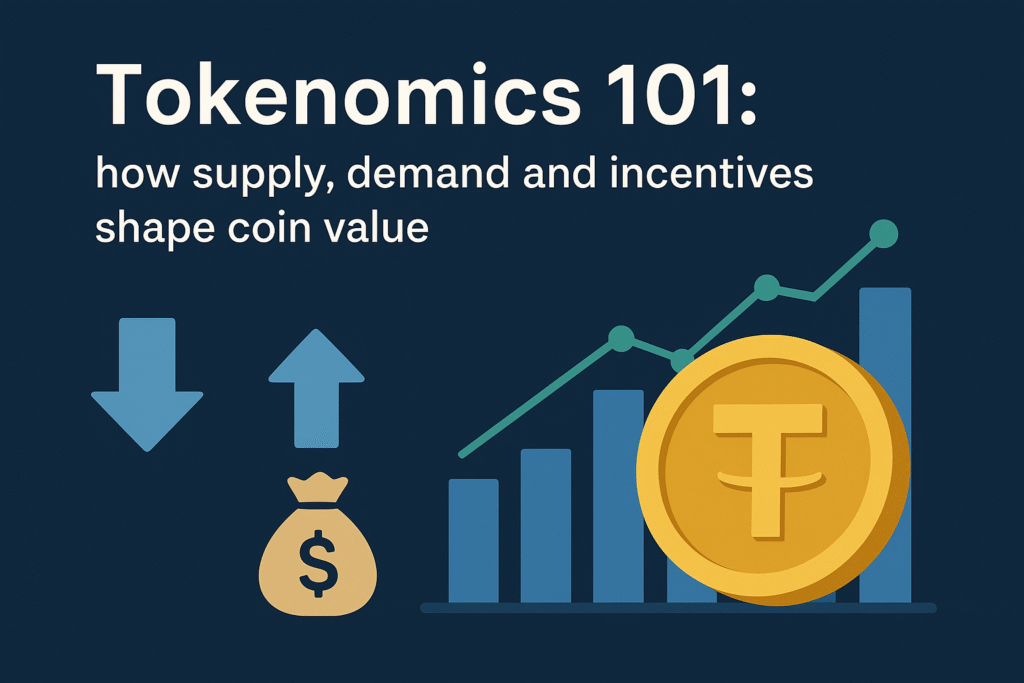Tokenomics 101: how supply, demand and incentives shape coin value
Introduction
Tokenomics is the study of how a cryptocurrency’s supply, demand, and the incentives built into its protocol interact to influence its value and behavior. It’s not just about clever code or dazzling tech; it’s about how economic forces, user behavior, and governance choices guide how much a token is wanted, how it circulates, and how participants are rewarded or penalized for their actions. A sound tokenomics design aligns the incentives of developers, investors, users, and validators so that the system tends toward sustainable growth rather than short-term hype.
Supply dynamics: what can change the quantity in circulation
– Fixed vs. dynamic supply: Some tokens have a hard cap (fixed maximum, like Bitcoin’s 21 million), while others have variable supply that can grow (inflation) or shrink (deflation) over time through issuance schedules, burns, or adaptive mechanisms.
– Circulating supply versus total supply: Circulating supply is what’s actually available in the market. Total supply includes coins that are locked, reserved, or not yet issued. A shift from vesting or release schedules can raise circulating supply over time, impacting price pressure.
– Issuance and rewards: Inflationary tokens pay ongoing rewards to stakers, validators, or protocol contributors. If issuance is too high relative to demand, it can dilute existing holders and exert downward price pressure; if issuance is well-tuned, it can support network growth without eroding value.
– Burns and deflationary mechanics: Some protocols burn a portion of transaction fees or governance taxes, reducing the overall supply over time. Burns can create scarcity advantages during high activity periods and can be a meaningful driver of price dynamics if demand holds steady or grows.
– Supply shocks and distribution: The initial distribution (founders, investors, community contributors) and how evenly it’s spread affect access, governance power, and perceived fairness. Large unlock events or concentrated holdings can create short-term price swings as supply is released or absorbed.
– Practical examples:
– Bitcoin: A simple, transparent constraint—2.1 million coins mined per year in early eras, tapering to a hard cap of 21 million. This fixed supply contributes to long-run scarcity and has been a major driver of its narrative as “digital gold.”
– Ethereum with EIP-1559 and staking: Base fees are burned, introducing a negative supply pressure during high network activity. Coupled with staking (which locks up ETH to participate in consensus), net issuance can be reduced or even negative at times, depending on network demand.
Demand dynamics: what makes people want to hold or use a token

– Utility and use cases: Tokens with clear, real-world or on-chain utility (payments, governance, access to services, collateral in DeFi) create baseline demand. The stronger and more diversified the use cases, the more robust the demand base.
– Network effects and growth: A token’s value often scales with the size and activity of its network. More users, developers, and apps create more reasons to hold and use the token, reinforcing demand through liquidity, convenience, and reputation.
– Liquidity and market access: Deep, efficient markets with tight spreads reduce the friction of buying and selling, making the token more attractive to investors and traders. Poor liquidity can cap demand even if the underlying utility is strong.
– Speculation and momentum: Traders may drive demand temporarily based on news, expectations, or herd behavior. While speculation can raise price in the short term, an underlying economic rationale is needed for sustainable gains.
– External factors: Regulation, macroeconomic trends, competing networks, security incidents, and overall crypto market mood can quickly alter demand. Positive developments (partnerships, upgrades, institutional interest) can lift demand; uncertainty can depress it.
– Practical examples:
– A governance token with strong on-chain voting and clear incentives for long-term holders can foster stable demand, as users want influence and a say in protocol direction.
– A payments-focused token that gains merchant adoption and user-friendly wallets will see demand driven by real-world utility and network convenience.
Incentives and design choices: how behavior is steered
– Staking and rewards: Staking rewards align holders with the health of the network. However, high staking yields can lock up supply, reducing liquid supply and potentially increasing price under steady demand.
– Fees, burns, and buybacks: Fee structures that redirect value back to token holders (burns, buybacks, or redistribution) create direct incentives to hold and can introduce scarcity during high-traffic periods.
– Governance rights: Tokens that confer voting power can incentivize long-term holding by aligning economic interest with protocol outcomes. Well-designed governance should balance influence against centralization risks.

– Liquidity mining and yield incentives: Liquidity providers earn rewards to bootstrap liquidity in DeFi ecosystems. While these incentives attract capital, they can also cause supply shifts and dependence on continued subsidy.
– Vesting and distribution: Founders, team members, and early backers often vest over time. This reduces immediate supply pressure and can stabilize early price volatility, but excessive concentration might raise concerns about future dilution or coordination risk.
– Security and reliability incentives: Investors pay a premium for protocols with strong security models, clear upgrade paths, and robust governance. Perceived security translates into lower risk and higher demand.
– Practical examples:
– A PoS protocol offers staking rewards and a governance token that enables protocol upgrades, encouraging long-term alignment and reducing the incentive to sell on the first pump.
– A DeFi token uses liquidity mining with diminishing rewards, gradually shifting reliance from subsidies toward organic growth in demand as users realize real value from the ecosystem.
Putting it together: how supply, demand, and incentives shape value
– Price is where market participants’ willingness to hold or spend balances with the supply available at that moment. If demand grows faster than supply, price tends to rise; if supply expands faster than demand, price can fall.
– Tokenomics is the toolkit that shapes those dynamics: how much is issued, how quickly, how it’s circulated, what burns occur, what rights buyers receive, and what actions players are rewarded or penalized for.
– A robust tokenomics design finds a sustainable rhythm: enough incentive to attract developers, users, and validators; a predictable, transparent issuance or burn schedule; and governance that preserves alignment among a broad stakeholder base.
Case studies and learning points
– Bitcoin as a scarcity narrative: A fixed supply with predictable issuance over time fosters a long-term scarcity story. The absence of a monetary policy oozes simplicity but leaves price dynamics dependent on demand growth and macro factors.

– Ethereum’s evolving supply dynamics: EIP-1559 introduced a predictable burn mechanism that reduces net issuance during busy periods, while staking reduces liquid supply through lockups. The combination can create a deflationary pressure that complements network growth, depending on usage levels.
– DeFi tokens with liquidity incentives: Many DeFi ecosystems use liquidity mining to attract capital and bootstrap trading venues. While this can accelerate growth, it may also create volatility in token supply and dependence on subsidy programs. Long-term value hinges on real utility and sustainable liquidity.
Practical takeaways for evaluating tokenomics
– Examine the emission schedule: Is issuance predictable? Are there scheduled reductions in supply growth? Are there any planned burns?
– Assess distribution and vesting: How evenly is the supply distributed? Are there long vesting periods to prevent sudden price shocks from large unlocks?
– Look for real utility: What is the token’s on-chain use case? Is there a clear path to scalable, sustainable demand?
– Consider governance and incentives: Do holders have meaningful governance rights? Are incentives aligned to long-term stewardship rather than short-term speculative actions?
– Check liquidity and market structure: Is there deep liquidity across major exchanges? Are there mechanisms to maintain orderly markets during volatility?
– Be mindful of risks: Dilution risk, centralization of ownership, security vulnerabilities, and regulatory uncertainties can all alter the expected relationship between supply, demand, and price.
Conclusion
Tokenomics is the art and science of shaping how a token’s supply, demand, and incentives interact to create value and guide behavior within a crypto ecosystem. By understanding emission/ burn mechanics, distribution, network utility, and governance design, investors and builders can better anticipate how a token might behave as the ecosystem matures. There is no single magic metric, but a coherent combination of supply discipline, meaningful use cases, and well-aligned incentives can foster sustainable demand and healthier price dynamics over time.

